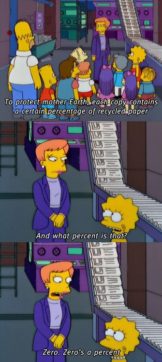
Newpaper spokesperson – “To protect mother earth, each copy contains a certain percentage of recycled paper.”
Lisa Simpson – “And what percent is that?”
Newpaper spokesperson – “Zero, Zero’s a percent”
Glitter Greenwashing
Greenwashing is the practice of making an unsubstantiated or misleading claim about the environmental benefits of a product, service, technology or company practice. Greenwashing can make a company appear to be more environmentally friendly than it really is.
Like many other industries, the glitter industry is not immune to the alure of greenwashing. It’s important that well-meaning, manufacturers, brand owners and consumers understand the issue, the terms and the buzzwords commonly used to mislead and deceive.
Glitter Greenwashing – What to look out for
We see glitter greenwashing in a number of guises. These include; the use of the term ‘biodegradable’ with no other information to quality what exactly this means or evidence to back up the claim. Declarations from suppliers with evidence to substantiate performance claims. Test reports that can look officious but when studied relate to testing conditions not related to environmental microplastic pollution or in some cases falsified.
Here are some basic things to be aware of when selecting your eco-friendly glitter products.
It’s important to remember glitter poses a microplastic pollution problem in the NATURAL ENVIRONMENT. Therefore, it only makes sense that eco-glitter biodegradability has to be relative to the NATURAL ENVIRONMENT.
The Term ‘Biodegradable Glitter’ DOES NOT:
- Confirm HOW MUCH it biodegrades
- Confirm HOW LONG it takes to biodegrade
- Confirm THE CONDITIONS in which it will biodegrade
Raw Material ‘Buzzwords’ used in Glitter Greenwashing
| Raw Material Buzzword | Biodegradability Performace – The Reality | |
| PLA or Polylactic Acid or Polylactide | Compostable but NOT biodegradable in the natural environment | |
| Cellulose Acetate or ‘Acetate’ | Compostable but NOT biodegradable in the natural environment | |
| Cellulose | Could mean many things! Cellophane™ is cellulose but DOES NOT pass any biodegradability test; composting or biodegradability in the natural environment | |
| Microcrystalline Cellulose | Glitter CANNOT be made from this. It is a fine white powder, used as the test standard in biodegradability testing |
Glitter Greenwashing – How To Avoid It
We have thought long and hard about this problem and as explained above there are a whole host of different forms of glitter greenwashing. Here are a few ways to avoid being glitter greenwashed.
1- Information, education and knowledge. We feel this is key as it empowers consumers, manufacturers and brands to ask the right questions to avoid oversimplified ‘greenwashed’ terms.
2 – Look for 3rd party testing even better certification. Test reports may look all official and good however expert knowledge is often required to understand if the results and data also test reports can be plagiarised.
Certification by reputable bodies like TÜV the best way to be sure. TÜV OK biodegradable WATER certification for example neatly wraps up all the critical elements associated with freshwater biodegradation; where: natural, freshwater environments, how long: <56days, how much: >90%, the validity of testing lab and data: ISO17025 accredited test laboratory, Ecotoxicity: through product evaluation not toxic in aquatic environments. TÜV certification is also well controlled, logos are serial marked and unique to the certified product and the TÜV website can be quickly checked to ensure a certificate is valid.
